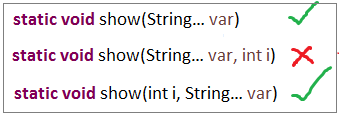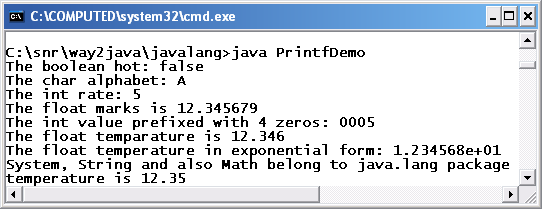Java5 Features(2005)
Annotations
Java Annotation is a tag that represents the metadata i.e. attached with class, interface, methods or fields to indicate some additional information which can be used by java compiler and JVM.
Annotations have a number of uses, among them:
-
Information for the compiler — Annotations can be used by the compiler to detect errors or suppress warnings.
-
Compile-time and deployment-time processing — Software tools can process annotation information to generate code, XML files, and so forth.
-
Runtime processing — Some annotations are available to be examined at runtime
The annotation can include elements, which can be named or unnamed, and there are values for those elements:
@Author(
name = "Benjamin Franklin",
date = "3/27/2003"
)
class MyClass() { ... }
If there is just one element named value, then the name can be omitted, as in:
@SuppressWarnings("unchecked")
void myMethod() { ... }
If the annotation has no elements, then the parentheses can be omitted
example : @Override
It is also possible to use multiple annotations on the same declaration:
@Author(name = "Jane Doe")
@EBook
class MyClass { ... }
If the annotations have the same type, then this is called a repeating annotation Repeating annotations are supported as of the Java SE 8 release.
@Author(name = "Jane Doe")
@Author(name = "John Smith")
class MyClass { ... }
Java Custom annotations or Java User-defined annotations are easy to create and use. The @interface element is used to declare an annotation.
-
Method should not have any throws clauses
-
Method should return something
-
Method should not have any parameter.
-
It may assign a default value to the method.
@interface MyAnnotation{ int value() default 0; }
Example
Suppose Every class in a given Project should contain author info. Writing
Author info in each every class is deficult like below
public class GenrateWorkSheet extends DataList {
// Author: John Doe
// Date: 3/17/2002
// Current revision: 6
// Last modified: 4/12/2004
// By: Jane Doe
// Reviewers: Alice, Bill, Cindy
// class code goes here
}
By Using Annotation we can provide above information.for doing this we need to create an annotation & all properties should define using methods.
@interface ClassPreamble {
String author();
String date();
int currentRevision() default 1;
String lastModified() default "N/A";
String lastModifiedBy() default "N/A";
// Note use of array
String[] reviewers();
}
Once annotation reday, you can write that annotation top of the each class with values
@ClassPreamble (
author = "John Doe",
date = "3/17/2002",
currentRevision = 6,
lastModified = "4/12/2004",
lastModifiedBy = "Jane Doe",
// Note array notation
reviewers = {"Alice", "Bob", "Cindy"}
)
public class Generation3List extends Generation2List {
// class code goes here
}
Autoboxing
The automatic conversion of primitive data types into its equivalent Wrapper type is known as boxing and opposite operation is known as unboxing.
Upto JDK 1.4, all the data structures of Java stores only objects and when retrieved returns objects. Autoboxing permits to store data types directly in DS and retrieve back data types.
If a method(remember only method – not direct) requires Integer Object value, we can directly pass primitive value without issue. Autoboxing will take care about these.
We can also do direct initializations (1.8 V)
Integer i = 10;// it will create Integer value of 10 using Autoboxing
int j = i;// ;// it will convert Integer to int using Autoboxing
Previously it shows
Integer i = 10;// it will create Integer value of 10 using Autoboxing
int j = i;//But we cant assign int to Integer Type mismatch: cannot convert from Integer to int
Generics
Generics are introduced in Java 1.5 Version to solve Type-safity & Type-casting problems
public class Student {
public static void main(String[] args) {
ArrayList l = new ArrayList(); //1>
l.add("Satya");
String s = (String) l.get(0); //2
System.out.println(s);
}
}
-
At line 1. ArrayList is NOT generic type – so we can add any type of elements results Type-Safety
-
At line 2. It returns added String data as Object. So manually we have to Type-cast to String
To resolve above problems Generics are introduced
public class Student { public static void main(String[] args) { ArrayList<String> l = new ArrayList<String>(); // 1 l.add("Satya"); String s = l.get(0); // 2 System.out.println(s); } }
Generics solves ClassCastException, beacause TYPE-CHECKING done at COMPILE-TIME itself
Generics can be used in following areas
-
Class level
-
Interface level
-
Constructor level.
-
Method level
Sample Generic class
class SmlGen<T> {
T obj;
void add(T obj) {
this.obj = obj;
}
T get() {
return obj;
}
}
The **
1.Type Parameter
-
T – Type - Any Type, can be use any level (Class, Interface, Methods…)
-
N – Number - Indicates it allows Number Types (int,long,float etec)
-
**E – Element - Exclusively used in Collection (ArrayList
)** -
K – Key - Map KEY area
-
V – Value - Map Value area
-
S,U,V etc. - 2nd, 3rd, 4th types
1. Generics at Class /Method /Constructor level
A generic class is defined with the following format.
class SmlGen<T> { //1.Class Level
T obj;
public SmlGen() {
}
public SmlGen(T obj) { //2.Constrcutor Level
this.obj = obj;
}
void add(T obj) {
this.obj = obj;
}
T get() { //3.Method Level
return obj;
}
}
public class Student {
public static void main(String[] args) {
SmlGen<String> s = new SmlGen<String>();
s.add("Satya");
System.out.println(s.get());
}
}
2. Generics at Interface level
A generic interface is same as gereric class.
public interface List<T> extends Collection<T> {
...
}
Wildcard in Generics
? Operator is used to represents wildcards in generics. We have to types of Wildcards
-
Unbounded wildcards
-
Bounded wildcards
1. Unbounded wildcards
Unbounded wildcard looks like <?> - means the generic can be any type.it is
not bounded with any type.
2. Bounded wildcards
<? extends T> and <? super T> are examples of bounded wildcards
<? extends T> : means it can accept the **Child class Objects of the
type
<? super T> : means it can accept the **Partent class Objects of the
type
Covariant Return Type (Java 5)
Before Java5, it was not possible to override any method by changing the return type. But now, since Java5, it is possible to override method by changing the return type if subclass overrides any method whose return type is Non-Primitive but it changes its return type to subclass type.
Enhanced for loop
-
For-each loop introduced in Java 1.5 version as an enhancement of traditional for-loop
-
Main advantage is we don’t need to write extra code traverse over array / collections
-
Mainly used for traverse on Array Elements & Collection Elements
for (Datatype temp_variable : Array/Collection Variable){}
1.for-each loop on Array Elements
public class Foreach {
public static void main(String[] args) {
int i[] = { 1, 2, 3, 4, 5, 6, 7, 8, 9, 10 };
for (int b : i) {
System.out.print(b+", ");
}
}
}
1, 2, 3, 4, 5, 6, 7, 8, 9, 10,
2.for-each loop on Collection Elements
public class Foreach {
public static void main(String[] args) {
ArrayList<String> l = new ArrayList<String>();
l.add("A");
l.add("B");
l.add("C");
l.add("D");
l.add("E");
for (String s : l) {
System.out.print(s + ",");
}
}
}
A, B, C, D, E
Varargs
Some times we don’t know no.of arguments used in our method implementation.var…args are introduced in 1.5v to solve these type of situations
static returntype methodname(Datatype … variblename)
public class Varargs {
static void show(String… var) {
System.out.println(-Show() called");
}
public static void main(String[] args) {
Varargs v = new Varargs();
v.show();
v.show(-A");
v.show(-A", -B", -C");
}
}
Show() called
Show() called
Show() called
Rules for using Var-args
1. Var-args must be as the last argument in method signature

2. Only one Var-arg is allowed per a Method

Enums
Enum in java is a data type that contains fixed set of constants.
-
enums improves type safety
-
easily used in switch
-
enum can be traversed
-
enum class is a just like normal class, we can write FIELDS, Constrcutors, Methods in enum class
-
enum CANNOT extend any class because it internally extends Enum class
-
enum may implement many interfaces
ALL fields in Enums by Default PUBLIC STATIC FINAL
1.Simple ENUM Example
enum Days {
MONDAY, TUESDAY, WEDNESDAY, THURSDAY, FRIDAY, SATURDAY, SUNDAY
}
public class EnumDemo {
public static void main(String[] args) {
for (Days s : Days.values()) {
System.out.print(s + ",");
}
}
}
MONDAY, TUESDAY, WEDNESDAY, THURSDAY, FRIDAY, SATURDAY, SUNDAY,
2.Enum with Values
To write Enum with values we have to follow below steps
-
Enum values must be placed inside ( ) MONDAY(1)
-
Take public instance variable to Store enum value public int Enum_Value;
-
Write private constructor which can take enum value as argument private Days(int Enu_Val)
enum Days {
MONDAY(1), TUESDAY(2), WEDNESDAY(3), THURSDAY(4), FRIDAY(5), SATURDAY(6), SUNDAY(7);
public int Enum_Value;
private Days(int Enum_Value) {
this.Enum_Value = Enum_Value;
}
}
public class EnumDemo {
public static void main(String[] args) {
for (Days s : Days.values()) {
System.out.println(s + ":"+s.Enum_Value);
}
}
}
MONDAY :1, TUESDAY:2, WEDNESDAY:3, THURSDAY :4, FRIDAY:5, SATURDAY:6 SUNDAY:7
Static imports
The static import feature of Java 5 facilitate the java programmer to access any static member of a class directly. There is no need to qualify it by the class name.
From 1.5 version onwords we can access any static member of a class directly. There is no need to qualify it by the class name.
import static java.lang.System.*;
public class StaticImport {
public static void main(String[] args) {
out.println("Static Import");
}
}
C-lang printf()
printf() is an extra method added to PrintStream class from JDK 1.5 version. printf() is used to print at command-prompt
public class PrintfDemo
{
public static void main(String args[])
{
boolean hot = false;
char alphabet = 'A';
int rate = 5;
float temperature = 12.3456789f;
System.out.printf("The boolean hot: %b", hot); // place holder b for boolean
System.out.printf("\nThe char alphabet: %c", alphabet); // c for char
System.out.printf("\nThe int rate: %d", rate); // d for int
System.out.printf("\nThe float marks is %f", temperature); // f for float
System.out.printf("\n value prefixed with 4 zeros: %04d", rate);// filling with zeros
System.out.printf("\float temp %.3f", temperature); // precision to three decimal values
System.out.printf("\nThe float temperature in exponential form: %e", temperature);
System.out.printf("\n%s, %s and also %s belong to java.lang package", "System","String","Math");
System.out.printf("\ntemperature is %4.2f", temperature); // width is 4 and precision to 2 decimal points
}
}

Java6 does not have many features